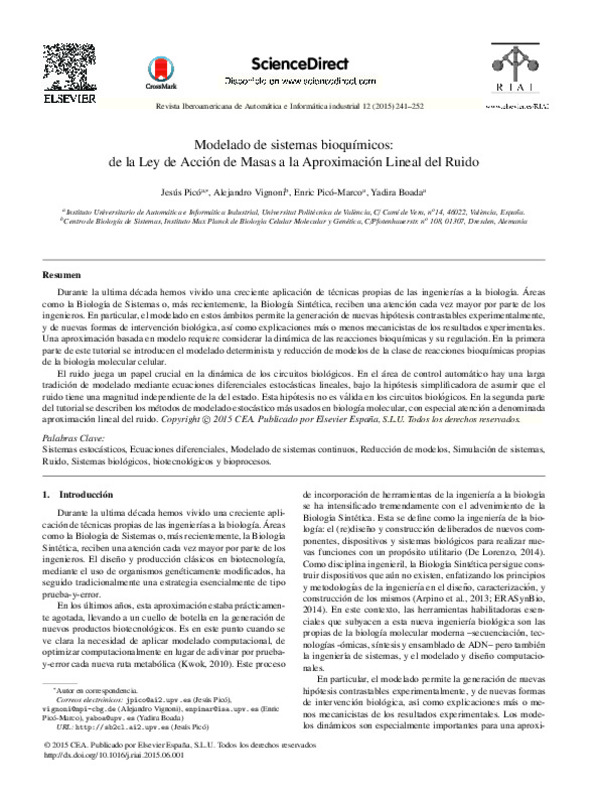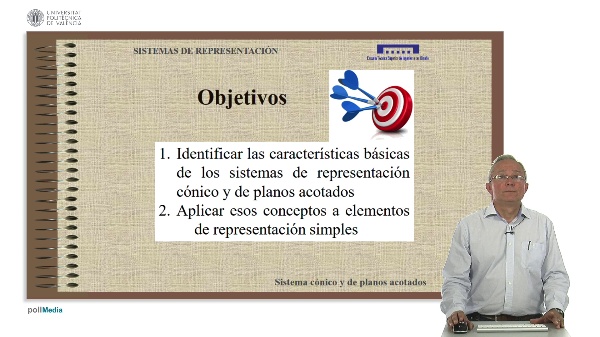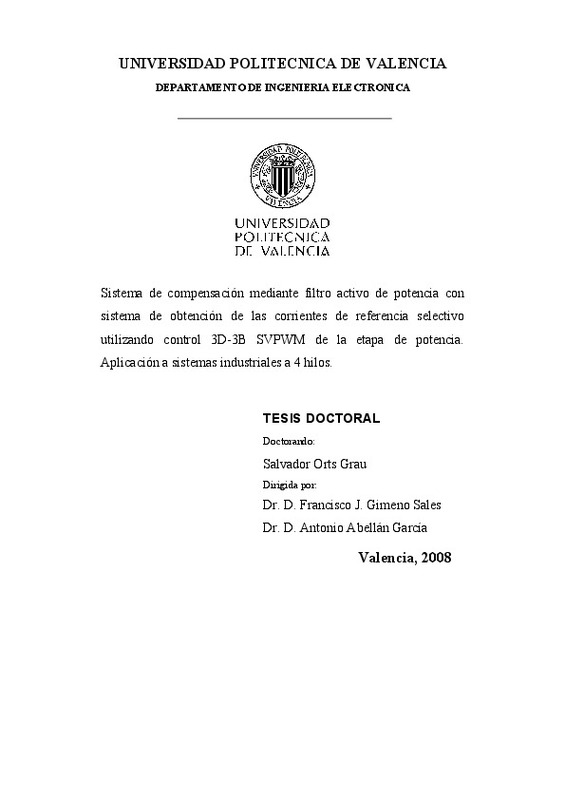JavaScript is disabled for your browser. Some features of this site may not work without it.
Buscar en RiuNet
Listar
Mi cuenta
Estadísticas
Ayuda RiuNet
Admin. UPV
Modelado de sistemas bioquímicos: De la Ley de Acción de Masas a la Aproximación Lineal del Ruido
Mostrar el registro sencillo del ítem
Ficheros en el ítem
| dc.contributor.author | Picó Marco, Jesús Andrés
|
es_ES |
| dc.contributor.author | Vignoni, Alejandro
|
es_ES |
| dc.contributor.author | Picó i Marco, Enric
|
es_ES |
| dc.contributor.author | Boada Acosta, Yadira Fernanda
|
es_ES |
| dc.date.accessioned | 2020-05-19T06:42:16Z | |
| dc.date.available | 2020-05-19T06:42:16Z | |
| dc.date.issued | 2015-07-10 | es_ES |
| dc.identifier.issn | 1697-7912 | es_ES |
| dc.identifier.uri | http://hdl.handle.net/10251/143649 | |
| dc.description.abstract | [EN] In the last decade we have witnessed a growing application of engineering techniques to biology. Areas such as Systems Biology or, more recently, Synthetic Biology, get more and more attention from the engineers. Specifically, modeling in these fields makes possible the generation of new experimentally verifiable hypothesis, and new ways of biological intervention, as well as more or less mechanistic explanations of experimental results. A model-based approximation requires the consideration of the biochemical reactions dynamics and their regulation. The first part of this tutorial describes the deterministic modeling and model reduction techniques, as applied to the class of biochemical reactions specific to molecular cell biology.Noise plays a crucial role in the biological circuitry dynamics. In the field of automatic control there is a long tradition of modeling using linear stochastic differential equations, under the simplifying assumption that noise has a magnitude independent of the state. This assumption is not valid in biological circuits. The second part of the tutorial describes the most widely used methods for stochastic modeling in molecular cell biology, paying special attention to the so-called linear noise approximation. | es_ES |
| dc.description.abstract | [ES] Durante la ultima década hemos vivido una creciente aplicación de técnicas propias de las ingenierías a la biología. Áreas como la Biología de Sistemas o, más recientemente, la Biología Sintética, reciben una atención cada vez mayor por parte de los ingenieros. En particular, el modelado en estos ámbitos permite la generación de nuevas hipótesis contrastables experimentalmente, y de nuevas formas de intervención biológica, así como explicaciones más o menos mecanicistas de los resultados experimentales. Una aproximación basada en modelo requiere considerar la dinámica de las reacciones bioquímicas y su regulación. En la primera parte de este tutorial se introducen el modelado determinista y reducción de modelos de la clase de reacciones bioquímicas propias de la biología molecular celular.El ruido juega un papel crucial en la dinámica de los circuitos biológicos. En el área de control automático hay una larga tradición de modelado mediante ecuaciones diferenciales estocásticas lineales, bajo la hipótesis simplificadora de asumir que el ruido tiene una magnitud independiente de la del estado. Esta hipótesis no es válida en los circuitos biológicos. En la segunda parte del tutorial se describen los métodos de modelado estocástico más usados en biología molecular, con especial atención a denominada aproximación lineal del ruido. | es_ES |
| dc.description.sponsorship | Este trabajo ha sido realizado parcialmente gracias al apoyo de los proyectos FEDER-CICYT DPI2011-28112-C04-01, y DPI2014-55276-C5-1. Yadira Boada agradece la beca FPI/2013- 3242 de la Universitat Politècnica de València. | es_ES |
| dc.language | Español | es_ES |
| dc.publisher | Universitat Politècnica de València | es_ES |
| dc.relation.ispartof | Revista Iberoamericana de Automática e Informática industrial | es_ES |
| dc.rights | Reconocimiento - No comercial - Sin obra derivada (by-nc-nd) | es_ES |
| dc.subject | Stochastic systems | es_ES |
| dc.subject | Differential equations | es_ES |
| dc.subject | Modeling of continuous systems | es_ES |
| dc.subject | Model reduction | es_ES |
| dc.subject | Simulation | es_ES |
| dc.subject | Noise | es_ES |
| dc.subject | Biological and biotechnological systems and bioprocesses | es_ES |
| dc.subject | Sistemas estocásticos | es_ES |
| dc.subject | Ecuaciones diferenciales | es_ES |
| dc.subject | Modelado de sistemas continuos | es_ES |
| dc.subject | Reducción de modelos | es_ES |
| dc.subject | Simulación de sistemas | es_ES |
| dc.subject | Ruido | es_ES |
| dc.subject | Sistemas biológicos | es_ES |
| dc.subject | Biotecnológicos y bioprocesos | es_ES |
| dc.title | Modelado de sistemas bioquímicos: De la Ley de Acción de Masas a la Aproximación Lineal del Ruido | es_ES |
| dc.title.alternative | Modelling biochemical systems: from Mass Action Kinetics to Linear Noise Approximation | es_ES |
| dc.type | Otros | es_ES |
| dc.identifier.doi | 10.1016/j.riai.2015.06.001 | es_ES |
| dc.relation.projectID | info:eu-repo/grantAgreement/MICINN//DPI2011-28112-C04-01/ES/MONITORIZACION, INFERENCIA, OPTIMIZACION Y CONTROL MULTI-ESCALA: DE CELULAS A BIORREACTORES/ | |
| dc.relation.projectID | info:eu-repo/grantAgreement/MINECO//DPI2014-55276-C5-1-R/ES/BIOLOGIA SINTETICA PARA LA MEJORA EN BIOPRODUCCION: DISEÑO, OPTIMIZACION, MONITORIZACION Y CONTROL/ / | |
| dc.relation.projectID | info:eu-repo/grantAgreement/UPV//FPI%2F2013-3242/ | |
| dc.rights.accessRights | Abierto | es_ES |
| dc.contributor.affiliation | Universitat Politècnica de València. Instituto Universitario de Automática e Informática Industrial - Institut Universitari d'Automàtica i Informàtica Industrial | es_ES |
| dc.contributor.affiliation | Universitat Politècnica de València. Escuela Técnica Superior de Ingeniería del Diseño - Escola Tècnica Superior d'Enginyeria del Disseny | es_ES |
| dc.contributor.affiliation | Universitat Politècnica de València. Escuela Técnica Superior de Ingenieros Industriales - Escola Tècnica Superior d'Enginyers Industrials | es_ES |
| dc.contributor.affiliation | Universitat Politècnica de València. Departamento de Ingeniería de Sistemas y Automática - Departament d'Enginyeria de Sistemes i Automàtica | es_ES |
| dc.description.bibliographicCitation | Picó Marco, JA.; Vignoni, A.; Picó I Marco, E.; Boada Acosta, YF. (2015). Modelado de sistemas bioquímicos: De la Ley de Acción de Masas a la Aproximación Lineal del Ruido. Universitat Politècnica de València. https://doi.org/10.1016/j.riai.2015.06.001 | es_ES |
| dc.description.accrualMethod | OJS | es_ES |
| dc.relation.publisherversion | https://doi.org/10.1016/j.riai.2015.06.001 | es_ES |
| dc.description.upvformatpinicio | 241 | es_ES |
| dc.description.upvformatpfin | 252 | es_ES |
| dc.type.version | info:eu-repo/semantics/publishedVersion | es_ES |
| dc.description.volume | 12 | es_ES |
| dc.description.issue | 3 | es_ES |
| dc.identifier.eissn | 1697-7920 | es_ES |
| dc.relation.pasarela | OJS\9358 | es_ES |
| dc.contributor.funder | Universitat Politècnica de València | |
| dc.contributor.funder | Ministerio de Ciencia e Innovación | es_ES |
| dc.contributor.funder | Ministerio de Economía y Competitividad | es_ES |
| dc.description.references | Arpino, J.A. J., Hancock, E.J., Anderson, J., Barahona, M., Stan, G.-B. V. B., Papachristodoulou, A., Polizzi, K., 7 2013. Tuning the dials of synthetic biology. Microbiology 159 (Pt 7), 1236-53. | es_ES |
| dc.description.references | Blanchini, F., & Franco, E. (2011). Structurally robust biological networks. BMC Systems Biology, 5(1), 74. doi:10.1186/1752-0509-5-74 | es_ES |
| dc.description.references | Boada, Y., Vignoni, A., Navarro, J.L., Picó, J., 2015. Improvement of a cle stochastic simulation of gene synthetic network with quorum sensing and feedback in a cell population. In: Proceedings ECC 15. | es_ES |
| dc.description.references | Chakrabarti, A., Miskovic, L., Soh, K. C., & Hatzimanikatis, V. (2013). Towards kinetic modeling of genome-scale metabolic networks without sacrificing stoichiometric, thermodynamic and physiological constraints. Biotechnology Journal, 8(9), 1043-1057. doi:10.1002/biot.201300091 | es_ES |
| dc.description.references | Chellaboina, V., Bhat, S., Haddad, W., Bernstein, D., 8 2009. Modeling and analysis of mass-action kinetics. IEEE Control Systems Magazine 29 (4), 60-78. | es_ES |
| dc.description.references | Chen, W. W., Niepel, M., & Sorger, P. K. (2010). Classic and contemporary approaches to modeling biochemical reactions. Genes & Development, 24(17), 1861-1875. doi:10.1101/gad.1945410 | es_ES |
| dc.description.references | Church, G.M., Elowitz, M.B., Smolke, C.D., Voigt, C.A., Weiss, R., 4 2014. Realizing the potential of synthetic biology. Nat Rev Mol Cell Biol 15 (4), 289-94. | es_ES |
| dc.description.references | De Lorenzo, V., 8 2014. Biología sintética: la ingeniería al asalto de la complejidad biológica. Arbor 190 (768), a149. | es_ES |
| dc.description.references | Del Vecchio, D. (2013). A control theoretic framework for modular analysis and design of biomolecular networks. Annual Reviews in Control, 37(2), 333-345. doi:10.1016/j.arcontrol.2013.09.011 | es_ES |
| dc.description.references | ERASynBio, 2014. Next steps for european synthetic biology: a strategic vision. Tech. rep., ERASynBio. URL: https://www.erasynbio.eu. | es_ES |
| dc.description.references | Gillespie, D. T. (2007). Stochastic Simulation of Chemical Kinetics. Annual Review of Physical Chemistry, 58(1), 35-55. doi:10.1146/annurev.physchem.58.032806.104637 | es_ES |
| dc.description.references | Higham, D.J., 1 2008. Modeling and simulating chemical reactions. SIAM Review 50 (2), 347-368. | es_ES |
| dc.description.references | Khalil, H.K., 2011. The Control Handbook. CRC Press, Ch. Two Timescale and Averaging Methods. | es_ES |
| dc.description.references | Kiparissides, A., Koutinas, M., Kontoravdi, C., Mantalaris, A., & Pistikopoulos, E. N. (2011). ‘Closing the loop’ in biological systems modeling — From the in silico to the in vitro. Automatica, 47(6), 1147-1155. doi:10.1016/j.automatica.2011.01.013 | es_ES |
| dc.description.references | Kwok, R. (2010). Five hard truths for synthetic biology. Nature, 463(7279), 288-290. doi:10.1038/463288a | es_ES |
| dc.description.references | Llaneras, F., Picó, J., 1 2008. Stoichiometric modelling of cell metabolism. J Biosci Bioeng 105 (1), 1-11. | es_ES |
| dc.description.references | Mélykúti, B., Hespanha, J. P., & Khammash, M. (2014). Equilibrium distributions of simple biochemical reaction systems for time-scale separation in stochastic reaction networks. Journal of The Royal Society Interface, 11(97), 20140054. doi:10.1098/rsif.2014.0054 | es_ES |
| dc.description.references | Milo, R., Jorgensen, P., Moran, U., Weber, G., Springer, M., 1 2010. Bionumbers-the database of key numbers in molecular and cell biology. Nucleic Acids Res 38 (Database issue), D750-3. | es_ES |
| dc.description.references | Munsky, B., Khammash, M., 2008. The finite state projection approach for the analysis of stochastic noise in gene networks. Automatic Control, IEEE Transactions on 53 (Special Issue), 201-214. | es_ES |
| dc.description.references | Differential algebra for control systems design: Constructive computation of canonical forms. (2013). IEEE Control Systems, 33(2), 52-62. doi:10.1109/mcs.2012.2234965 | es_ES |
| dc.description.references | Scott, M., Hwa, T., Ingalls, B., 5 2007. Deterministic characterization of stochastic genetic circuits. Proc Natl Acad Sci U S A 104 (18), 7402-7. | es_ES |
| dc.description.references | Scott, M., Ingalls, B., Kaern, M., 6 2006. Estimations of intrinsic and extrinsic noise in models of nonlinear genetic networks. Chaos 16 (2), 026107. | es_ES |
| dc.description.references | Sundararaj, S., Guo, A., Habibi-Nazhad, B., Rouani, M., Stothard, P., Ellison, M., Wishart, D.S., 1 2004. The cybercell database (ccdb): a comprehensive, self-updating, relational database to coordinate and facilitate in silico modeling of escherichia coli. Nucleic Acids Res 32 (Database issue), D293-5. | es_ES |
| dc.description.references | Villaverde, A. F., & Banga, J. R. (2014). Reverse engineering and identification in systems biology: strategies, perspectives and challenges. Journal of The Royal Society Interface, 11(91), 20130505. doi:10.1098/rsif.2013.0505 | es_ES |
| dc.description.references | Wallace, E. W. J., Petzold, L. R., Gillespie, D. T., & Sanft, K. R. (2012). Linear noise approximation is valid over limited times for any chemical system that is sufficiently large. IET Systems Biology, 6(4), 102-115. doi:10.1049/iet-syb.2011.0038 | es_ES |
| dc.description.references | Zagaris, A., Kaper, H.G., Kaper, T.J., 1 2004. Analysis of the computational singular perturbation reduction method for chemical kinetics. Journal of Nonlinear Science 14 (1), 59-91. | es_ES |











